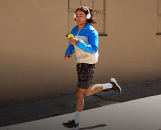Are Rest Days Important? Yes—Here’s Why
Your Body Can Repair Itself
You’ll Prevent Injuries
You’ll Actually Perform Even Better.
You’ll Improve Your Sleep.
Exactly How to Take a Rest Day
We get it: When you’ve been working hard to reach your fitness goals, it sometimes feels unproductive to take a day off. But recovery day is actually a crucial piece of your training—you need rest to grow stronger and healthier. We talked with Yuri Feito, PhD, associate professor of exercise science at Kennesaw State University in Kennesaw, Georgia, to learn about why rest days are just as important as high-intensity workouts—plus, what actually happens to your body during rest days.
Are Rest Days Important? Yes—Here’s Why
“Any exercise is stressful for the body,” says Dr. Feito. As you work out—whether it’s riding a Peloton Bike, running on a Peloton Tread, or lifting heavy weights in a strength class—your muscle fibers are tearing and your heart rate, blood pressure, and temperature all soar. “You provide a stimulus to the body, and the body adapts. You provide a greater stimulus and the body adapts. But if you continue to do that, at some point the body is going to start breaking down,” says Dr. Feito. That’s when you start feeling aches and pains—and you’re at a greater risk of becoming injured.
However, some stress—followed by proper recovery—will ultimately make you stronger. After a workout, torn muscle fibers begin rebuilding, enabling your muscles to get bigger. “Recovery allows those fibers to heal and muscle proteins to synthesize so those muscles can grow and be ready for the next training session,” says Dr. Feito. “Your body’s recovery process is where most of the growth occurs.”
We get it—sometimes it’s hard to slow down. While the influx of daily endorphins can be exhilarating, you need to acknowledge how hard your body and mind are working. “It’s important to give your body that time to rest. I know how hard we work on the Peloton Bike, so you have to take a day to slow things down. You earned it so you deserve it,” says Peloton cycling instructor Alex Toussaint. Famous for his “feel good” ethos, Alex makes rest a priority, and it’s part of his strategy for success.
Here’s a deeper look at the benefits of rest days within your busy training schedule.
Your Body Can Repair Itself
A little physiology refresher: When you work out, your muscle fibers get tiny, microscopic tears. Unlike an injury, these tears are nothing to be alarmed by; in fact, your body repairs these tears on its own, and that’s what leads to muscle growth. But if you’re constantly riding, cycling, or lifting, with no breaks, your body can’t take on those repairs. So if you’re training as hard as possible but not seeing the gains you want, try taking a rest day—that just may be the key to improving your mile time or PR.
You’ll Prevent Injuries
You might joke that you’re addicted to chasing new PRs on your Peloton or otherwise, but the truth is, training as hard as possible every single day has a cumulative wearing effect on your body. You’re risking two different types of injuries by ignoring rest days: overuse injuries and acute injuries. Let’s break it down.
Overuse injuries stem from training nonstop, without any time for recovery. You’ll experience an overuse injury in the muscle group that’s doing most of the work in your fitness activity of choice. Runners, for example, may be prone to shin splints, plantar fasciitis, or stress fractures, while cyclists could include cyclists’ knee or tendinitis. The only prevention? More rest.
Acute injuries, meanwhile, happen suddenly (rather than overuse injuries, which build up over time). An acute injury would most likely be tied to muscle fatigue and an inability to maintain good form. Translation: You’ve exhausted your muscles and they’re no longer able to perform the way you want them to, and poor form leads to injuries, such as tearing a muscle, spraining an ankle from landing improperly, or worse. Taking a few rest days regularly helps your body reset so you can tackle the next workout with full strength.
“Remember, a recovery day does not mean weakness,” says Peloton instructor Emma Lovewell, ”it means you’re taking care of yourself and connecting to how you feel. You have to be able to listen to your body in order to know when and how to push or rest it.” She equates this to interval training. “You can’t push to your max effort for a full 45 minutes. You need a few seconds, or minutes, to recover so you can hit that max effort again and again!” Don’t frame taking it slow as a sign of weakness–see it as part of the process of getting stronger and pushing your limits over time.
You’ll Actually Perform Even Better.
You know that feeling when you’ve had a great night of sleep and you bound out of bed, ready to take on the world? Rest days are like that, but for your muscles. After a legit rest day, you’ll feel the benefits of being fully recovered (think: more energy, slower to fatigue, and optimized fast-twitch muscles)—which may be the key to unlocking a new level of performance.
And just as important as physical performance, your mental performance improves after a rest day too. You’ll avoid burnout by taking a break from your usual workout schedule, and you’ll find yourself more excited to hit the Bike or Tread when it’s time to work out again. “I think an important part of recovery days is deliberately taking time to reflect on what you’ve already achieved,” says Peloton instructor Cody Rigsby. “When you can clearly see your progress, I believe it motivates you even more to get back at it the next day.”
You’ll Improve Your Sleep.
You might be thinking “Wait, I thought wearing myself out through exercise was key to sleeping well.” While singular sessions of physical activity can have a small impact on sleep, the real benefit comes from regular, moderate-intensity exercise over long periods of time.
So how do rest days fit in? When you’re exercising, you’re increasing the levels of cortisol—a stress hormone—and adrenaline in your body. If you’re exercising regularly (which is great!), you may be at risk of overproducing these hormones, which can lead to restlessness, agitation, or feeling higher stress levels than normal-—all of which can make it harder to get those quality zzz’s at night. A rest day, meanwhile, lets your hormones return to homeostasis (aka their balanced levels) so you can get that sweet, sweet shut-eye.
Exactly How to Take a Rest Day
So now that you know exactly why rest days are important, it’s time to learn how to take a rest day, how many rest days a week you should aim for, and more. Let’s break it down.
Learn the Signs That You Need a Rest Day
Trust us, it’s better not to wait until your body is so totally tired or injured that you’re forced to take a rest day. Learn to recognize the signs that your body is approaching overwork or burnout, and schedule rest days accordingly. Some examples may be an old injury flaring up, your recovery tracker showing a higher resting heart rate than normal, or you simply feeling tired and uninspired when it’s time to work out.
Determine How Many Rest Days a Week You Need
There’s no hard-and-fast rule for how many rest days a week your body needs, but in general, one to three is appropriate. Your perfect amount of rest days will vary based on your goals, your workout preferences, and your capabilities. For example, someone who loves high-impact activities like HIIT or boxing may need more active rest days. Meanwhile, a low-impact Pilates regular or someone who strength trains different muscle groups each day can probably get away with fewer rest days.
Of course, if you feel yourself approaching injury or feeling burnt out from your workouts, take as much time as you need to recover.
Learn What to Do on Rest Days
While you may enjoy the occasional day of fully vegging out on the couch, the best way to enjoy a rest day is with some light, low-impact activity. Think: a leisurely walk around the neighborhood, a low-impact Peloton ride, or a restorative yoga class. That way, your body gets a little bit of movement and you’re able to increase blood flow to your tired muscles, providing them with essential nutrients and oxygen for recovery.
Rest days are a crucial part of any fitness routine, as they allow the body time to recover. While you might be nervous to take a rest day, ultimately, you’ll find paying attention to your body helps you become even stronger.
This content is for informational and educational purposes only and does not constitute individualized advice. It is not intended to replace professional medical evaluation, diagnosis, or treatment. Seek the advice of your physician for questions you may have regarding your health or a medical condition. If you are having a medical emergency, call your physician or 911 immediately.
Level up your inbox.
Subscribe for a weekly dose of fitness, plus the latest promos, launches, and events.
By providing your email address, you agree to receive marketing communications from Peloton.
For more about how we use your information, see our Privacy Policy.




